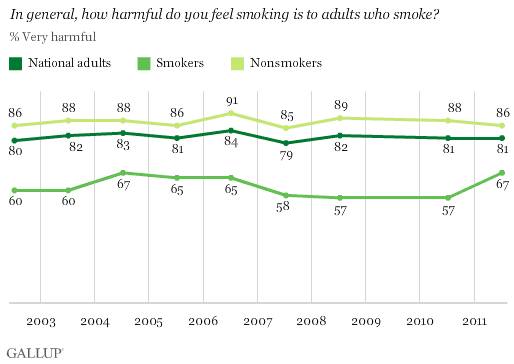WASHINGTON, D.C. -- Two in three U.S. smokers now agree that smoking is "very harmful" to adults who smoke, tying the most who have ever said so, but still trailing the more than 8 in 10 Americans and nonsmokers who say the same.

The findings are from Gallup's annual consumption poll, conducted July 7-10, 2011, which measures Americans' attitudes on many issues involving smoking, drinking, and weight. The views of "smokers" in 2011 are based on 170 respondents who reported smoking any cigarettes in the past week. The 67% of smokers who say smoking is very harmful is up from the past three years, matching the prior high found in 2004. Americans overall have barely budged over the past decade in their high level of agreement that smoking is very harmful to adults who smoke, with 81% saying so this year.
There is less consensus among Americans that secondhand smoke is very harmful. The percentage of Americans who agree -- 54% this year -- has been remarkably steady over the past decade, even as new studies emerge linking secondhand smoke to various ailments. The 35% of smokers and 59% of nonsmokers who agree are also within the range that Gallup has typically found.

The risks of smoking and secondhand smoke are widely documented and acknowledged. The National Cancer Institute estimates that cigarette smoking causes 443,000 deaths each year and that exposure to secondhand smoke causes approximately 49,400 of those deaths. Recent studies have also linked secondhand smoke to behavior and learning problems among children and hearing loss among teenagers.
Implications
Americans' views about the risks of smoking and secondhand smoke have held largely steady in recent years, even as the percentage who support a ban on smoking in all public places surged to a record high this year. Together, the findings suggest that Americans have largely made up their minds about the risks of smoking, and that nonsmoking Americans want to see more action to protect them from the danger they perceive from secondhand smoke.
For their part, smokers have returned to a higher level of acknowledgment of the risks of smoking and secondhand smoke. Further, these views coincide with slightly lower levels of smoking overall; 22% of Americans now report smoking in the past week, compared with 28% in 2001.
Gallup's annual consumption survey and the Gallup-Healthways Well-Being Index survey will continue to monitor smoking patterns and attitudes in future years.
View more Gallup data about smoking.
Survey Methods
Results for this Gallup poll are based on telephone interviews conducted July 7-10, 2011, with a random sample of 1,016 adults, aged 18 and older, living in all 50 U.S. states and the District of Columbia.
For results based on the total sample of national adults, one can say with 95% confidence that the maximum margin of sampling error is ±4 percentage points.
For results based on the total sample of 170 smokers, one can say with 95% confidence that the maximum margin of sampling error is ±9 percentage points.
Interviews are conducted with respondents on landline telephones and cellular phones, with interviews conducted in Spanish for respondents who are primarily Spanish-speaking. Each sample includes a minimum quota of 400 cell phone respondents and 600 landline respondents per 1,000 national adults, with additional minimum quotas among landline respondents by region. Landline telephone numbers are chosen at random among listed telephone numbers. Cell phone numbers are selected using random-digit-dial methods. Landline respondents are chosen at random within each household on the basis of which member had the most recent birthday.
Samples are weighted by gender, age, race, Hispanic ethnicity, education, region, adults in the household, and phone status (cell phone only/landline only/both, cell phone mostly, and having an unlisted landline number). Demographic weighting targets are based on the March 2010 Current Population Survey figures for the aged 18 and older non-institutionalized population living in U.S. telephone households. All reported margins of sampling error include the computed design effects for weighting and sample design.
In addition to sampling error, question wording and practical difficulties in conducting surveys can introduce error or bias into the findings of public opinion polls.
View methodology, full questions results, and trend data.
For more details on Gallup's polling methodology, visit www.gallup.com.
